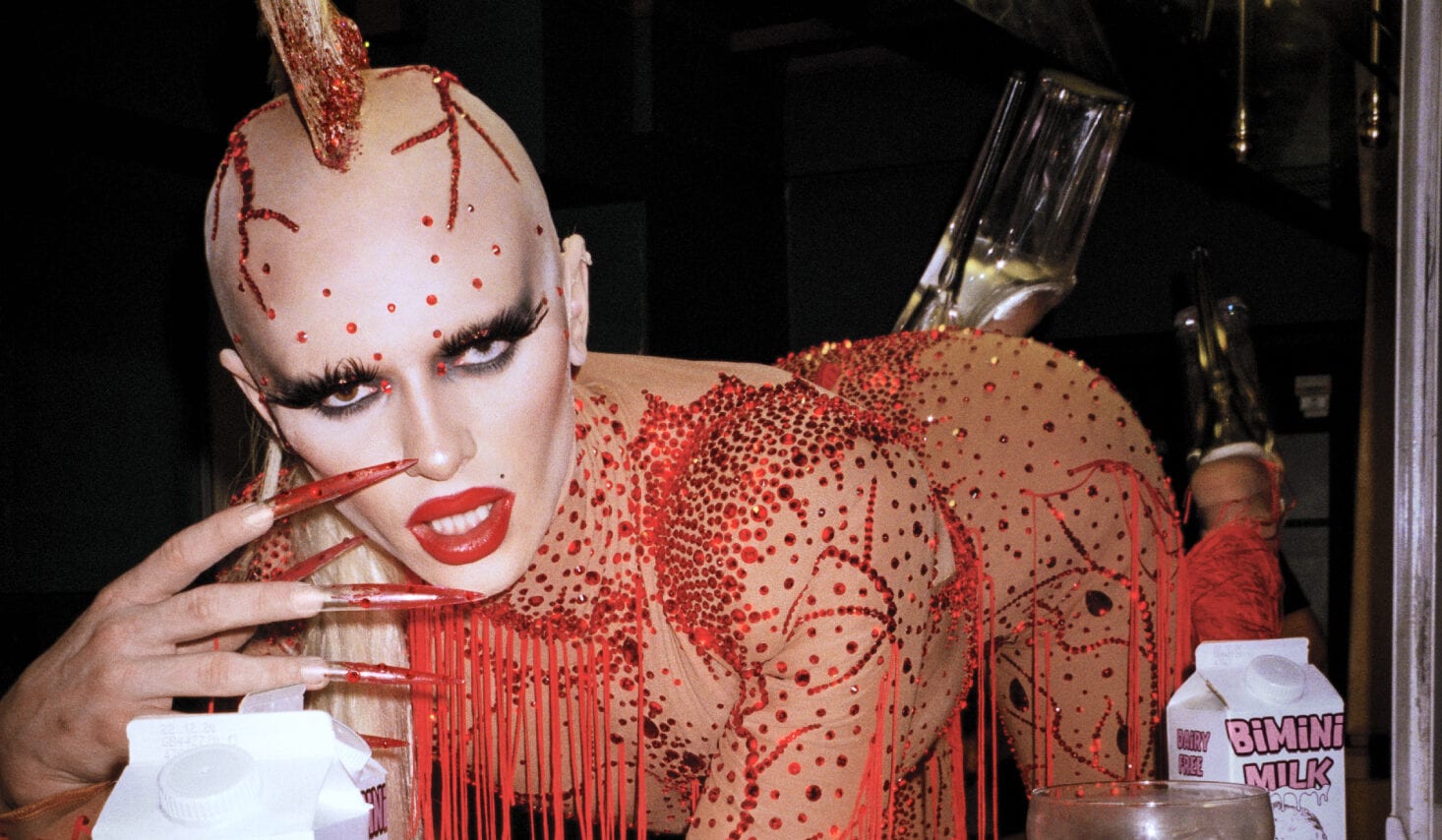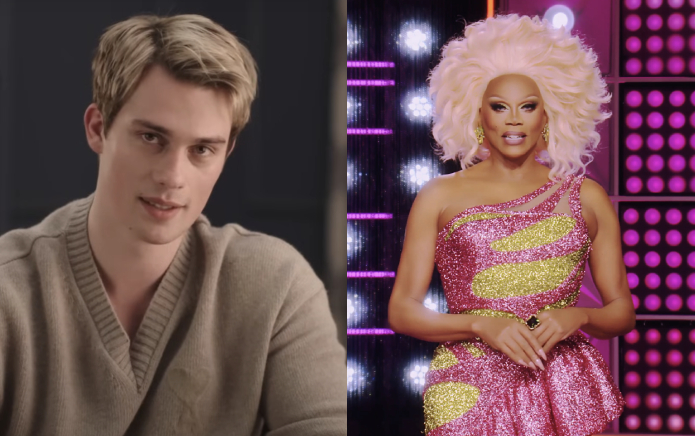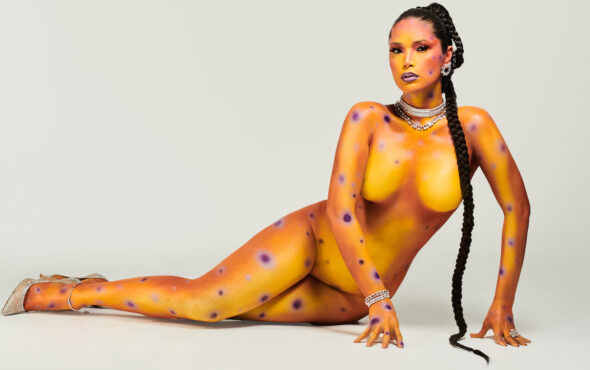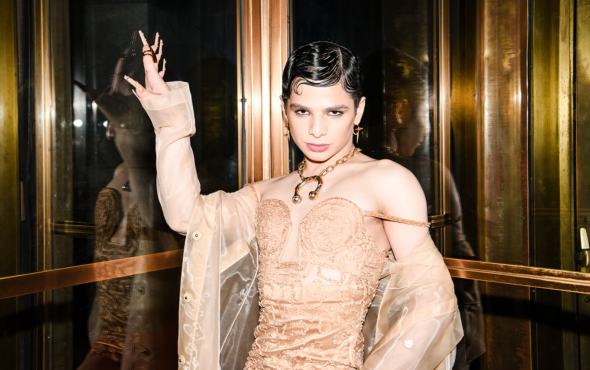
Everyone’s favourite vegan and fashionista on the East London scene sits down with us on World Earth Day, fresh from presenting Depop’s Let’s Talk. Are you looking to dabble in all things sustainable? Then Bimini has the perfect guide for a greener life.
Why was it important for you to collaborate with Depop for the Let’s Talk panel discussion, particularly this episode centring around World Earth Day?
Before I was even doing drag I was always self conscious as I can be, environmentally. I used to do a lot of festivals, we were called the Eco Warriors, we would go around picking up people’s rubbish and we would wear these green capes and make a thing of it. It was campy and silly. I’ve always tried to be. I’ve been vegan for six/seven years now and I was vegetarian before that. I was always conscious of what animal agriculture does to the planet. But, it doesn’t stop there. It stems into the materials we use, and the fashion industry as well. And it’s so difficult being a queen and trying to be as resourceful as possible. That’s why there’s always good places to look like Depop where you can find something, and also charity shops. I was always finding looks and piecing things together. I think giving something a second life is really cool because it’s already had one, and you’re giving it another one. Hopefully a better one.
Touching upon the idea of recycling fashion, whether it’s editorial or the Drag Race main stage, how do you take references from the likes of Alexander McQueen, Vivienne Westwood and put a sustainable spin on it?
It can be difficult. A lot of fabrics we’d find second hand or they’d be upcycled or repurposed. It’s just about trying to find out where your fabrics are from because that’s another big issue. You can go to some places in London, like Walthamstow, and get really cheap fabric. But like, why is it so cheap? What’s the process it’s been through? I think, for me, it’s all about having that balance and knowing when I’m doing drag all the time, it’s not 100% feasible to be able to be like, ‘Everything I get is second hand.’ But this is for everyone, it’s all about having that balance and consciousness. Where are you getting your things from? Where are you sourcing it from? Where is it coming from? Why should you be using things that have already been there? If you look at the amount of leather waste, for example. We could stop leather production and go another thirty or fourty years just reusing the leather that’s already there and repurposing it. That just doesn’t happen because the industry is just so big, but having these conversations are really important. There’s a lot of young designers actually now out there. More so the younger ones, and some older ones who are stopping fur production and things, but a lot of the younger ones are really making a statement by using only things that are upcycled or repurposed. I think that’s a really important conversation to be having in fashion, particularly high fashion.
Definitely! Like you said, it’s the balance but also having a conscious awareness of what you are consuming as a buyer. For anyone that is looking at World Earth Day and thinks change is overwhelming or an extreme change to their lifestyle, what are some baby steps we all could take to be more environmentally conscious?
It’s that thing as well, it’s like a packaging thing. You don’t even think about that when you’re buying things online. I think now the shops are open, going out to charity shops or going to places where you can reduce your packaging. I know with Depop, they are really good with sustainable practices. But, there’s some brands that I’ve worked with that have sent packaging that’s edible. There’s so many cool ideas out there and innovative ways that can be done. I do think as people there’s only so much that can be done. We can educate ourselves. We can try and conserve as much water. We can shop sustainably. We can change our lightbulb and do things like this. But, it ultimately needs to trickle up because normally it’s the trickle down effect. We need to be making the change on a lower level, so the people in power are going to be like, ‘Oh, actually this is an issue we do need to tackle.’ Because we all share the planet. If it’s going down, we’re all going down with it.
You’re right, it’s the voice of the people.
It’s totally that. It’s hard because the world is run by so many big corporations. It’s a really difficult issue to tackle because a lot of money and industries are responsible for a lot of the terrible things happening. So as consumers, we need to change the way we think about things. It’s been hard, I’ve done things where I’ve tried to be plastic free for as long as possible and you don’t realise how difficult it can be. We’ve seen the places where these cheap places are being made, in countries where they are getting paid nothing for us to wear something for pennies, and that’s just an unethical practice. There needs to be a whole overhaul shift.
What was the process like curating your list of Depop sellers? What were you looking for? Was it charisma, uniqueness, nerve and talent?
Well, I work alongside my best mate and creative partner. We bounce ideas and come up with looks. We’re heavily inspired by fashion, but we both know you don’t have to ultimately buy designer to make something look good. It’s all an attitude and about how you wear it. We’ve always been looking on Depop, and we share an account. There’s sellers like Isabelle, who I’ve worked with in the past and she’s a big seller on Depop. There’s ROSAYAB who does sustainable patchwork for womenswear, which is really cool. The Savage Sister are really big on the game, they sell second hand designer stuff. I think it was just going through people who we had worked with and resonated with us. That’s kind of the roots we go down when we pick outfits.
That’s a lovely note. Anyone looking at your curated list can go and look at the sellers and get a taste of the Bimini look!
I heavily reference fashion and there’s elements of punk, elements of 00s, elements of 90s. There’s always a set style but having your own one is timeless, that can always change. You don’t have to look at someone in a magazine and be like, ‘I’m going to look like that head to toe.’ You can pull things you like and piece it together and see what works. It’s about mixing and matching and pulling pieces that are going to last you, rather than you’re going to get one wear out of it.
How do you want to influence the future of fashion? What kind of spaces do you want to break into within the industry?
I’d like to see more people like me in fashion and more people like me getting opportunities in the world. The future of fashion is always in the youth and the young designers. There’s a younger generation now. One of the designers I have a close relationship with in East London is ART SCHOOL. They’re queer and they just don’t care. They put all types of bodies on their runways and they show the beauty of the human, rather than just mannequins for an outfit. I think that’s the future, the future is really opening it up to be more diverse and sustainable. That’s another thing about ART SCHOOL. They reuse a lot of fabrics and that’s what it’s about, giving new life to products that are already there. It’s so easily achievable. Gone are the days of turning your nose up at that. We need to take what’s there and turn it into something even more extravagant, even more beautiful.
How has East London, as an environment, influenced your fashion and sense of style?
I’m never afraid to take risks. Maybe they don’t pay off, but it doesn’t mean I’m not going to do it. That’s the thing with having your style and making looks, I’m always looking for what’s next and what’s different to what I’ve already done. I like to reference things from the past. Me and Ella who I work with, we always look at what we’ve done and how we can make it better. I think East London has allowed me to have those freedoms, because I came up on the scene with Sink the Pink where people were walking around with lampshades on their head; all this crazy stuff that’s really shaped my belief that you can really go for it and be experimental. I never want anyone to know what I’m going to do next. I want people to think, ‘That’s just Bimini.’ I want people to be, not afraid, but excited for what I’m going to wear next.


